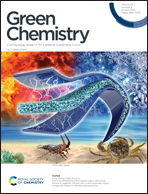Use of an [EMIM][OAc]/GVL-based organic electrolyte solvent to engineer chitosan into a nanocomposite organic ionogel electrolyte for flexible supercapacitors†
Abstract
Taking advantage of the facile dissolution of chitosan in the green [EMIM][OAc]/GVL-based organic electrolyte solution (OES) and the satisfactory ionic conductivity of the OES, a one-pot strategy for the preparation of a sustainable chitosan/nano-SiO2 nanocomposite organic ionogel electrolyte (CSOIE) was successfully demonstrated through the integration of in situ physical cross-linking via hydrogen bonding using nano-SiO2 and a solution-gel transition induced by moisture after the dissolution of chitosan in the OES. The [EMIM][OAc]/GVL OES not only acted as an efficient solvent for chitosan dissolution, but also ensured high ionic conductivity of the organic ionogel electrolyte and desired electrochemical performance in the assembled flexible supercapacitors over a wide working temperature range. It was found that the storage modulus of the chitosan/nano-SiO2 nanocomposite organic ionogel electrolyte (CSOIE) increased with an increase in the content of nano-SiO2, and the introduction of nano-SiO2 particles into the gel matrix enhanced the mechanical properties and ionic conductivity simultaneously. The as-prepared C8S2OIE sample exhibited high ionic conductivity over a wide temperature range (2.3, 24.3 and 60.3 mS cm−1 at −25, 25 and 80 °C, respectively), and a desirable compressive stress of 1.52 MPa at 25 °C. The assembled flexible supercapacitor using the C8S2OIE sample displayed excellent capacitive performance and temperature-dependent specific capacitance (72.8, 84.6 and 113.2 F g−1 at −25, 25 and 80 °C at 0.1 A g−1, respectively), and long-term stability after 10 000 charge–discharge cycles. It is believed that the satisfactory mechanical properties of the as-prepared CSOIE can be ascribed to both the physically cross-linked chitosan chains via hydrogen bonding and chain entanglement, as well as hydrogen bonding interactions between chitosan chains and nano-SiO2 particles; moreover, the physical interactions were beneficial for the formation of desirable ion channels, thus enabling outstanding electrochemical properties. Consequently, the findings provide significant insights for the design and preparation of sustainable organic ionogel electrolytes using natural polymers, and the outstanding performance of the as-prepared CSOIE suggests significant potential applications in flexible energy storage and conversion devices in the future.
![Graphical abstract: Use of an [EMIM][OAc]/GVL-based organic electrolyte solvent to engineer chitosan into a nanocomposite organic ionogel electrolyte for flexible supercapacitors](/en/Image/Get?imageInfo.ImageType=GA&imageInfo.ImageIdentifier.ManuscriptID=D2GC04019K&imageInfo.ImageIdentifier.Year=2023)


 Please wait while we load your content...
Please wait while we load your content...